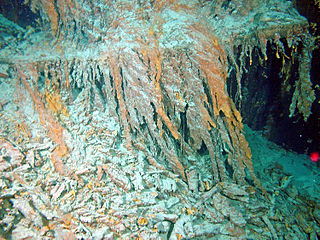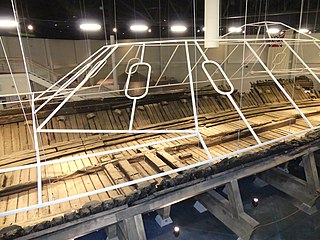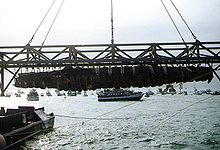
Rust is an iron oxide, a usually reddish-brown oxide formed by the reaction of iron and oxygen in the catalytic presence of water or air moisture. Rust consists of hydrous iron(III) oxides (Fe2O3·nH2O) and iron(III) oxide-hydroxide (FeO(OH), Fe(OH)3), and is typically associated with the corrosion of refined iron.

A submarine is a watercraft capable of independent operation underwater. It differs from a submersible, which has more limited underwater capability. The term is also sometimes used historically or colloquially to refer to remotely operated vehicles and robots, as well as medium-sized or smaller vessels, such as the midget submarine and the wet sub. Submarines are referred to as boats rather than ships irrespective of their size.

USS Housatonic was a screw sloop-of-war of the United States Navy, gaining its namesake from the Housatonic River of New England.

H. L. Hunley, also known as the Hunley, CSS H. L. Hunley, or CSS Hunley, was a submarine of the Confederate States of America that played a small part in the American Civil War. Hunley demonstrated the advantages and dangers of undersea warfare. She was the first combat submarine to sink a warship (USS Housatonic), although Hunley was not completely submerged and, following her attack, was lost along with her crew before she could return to base. Twenty-one crewmen died in the three sinkings of Hunley during her short career. She was named for her inventor, Horace Lawson Hunley, shortly after she was taken into government service under the control of the Confederate States Army at Charleston, South Carolina.

Corrosion is a natural process that converts a refined metal into a more chemically stable oxide. It is the gradual deterioration of materials by chemical or electrochemical reaction with their environment. Corrosion engineering is the field dedicated to controlling and preventing corrosion.

Cathodic protection is a technique used to control the corrosion of a metal surface by making it the cathode of an electrochemical cell. A simple method of protection connects the metal to be protected to a more easily corroded "sacrificial metal" to act as the anode. The sacrificial metal then corrodes instead of the protected metal. For structures such as long pipelines, where passive galvanic cathodic protection is not adequate, an external DC electrical power source is used to provide sufficient current.

A rusticle is a formation of rust similar to an icicle or stalactite in appearance that occurs deep underwater when wrought iron oxidizes. They may be familiar from underwater photographs of shipwrecks, such as the RMS Titanic and the German battleship Bismarck. They have also been found in the #3 turret, 8-inch gun turret on the stern remains in place of the USS Indianapolis. Rusticles are created by microbial organisms that consume iron.

Horace Lawson Hunley was a Confederate marine engineer during the American Civil War. He developed early hand-powered submarines, the most famous of which was posthumously named for him, 'H. L. Hunley'.

Ferrocement or ferro-cement is a system of construction using reinforced mortar or plaster applied over an "armature" of metal mesh, woven, expanded metal, or metal-fibers, and closely spaced thin steel rods such as rebar. The metal commonly used is iron or some type of steel, and the mesh is made with wire with a diameter between 0.5 mm and 1 mm. The cement is typically a very rich mix of sand and cement in a 3:1 ratio; when used for making boards, no gravel is used, so that the material is not concrete.

Sub Marine Explorer is a submersible built between 1863 and 1866 by Julius H. Kroehl and Ariel Patterson in Brooklyn, New York for the Pacific Pearl Company. It was hand powered and had an interconnected system of a high-pressure air chamber or compartment, a pressurized working chamber for the crew, and water ballast tanks. Problems with decompression sickness and overfishing of the pearl beds led to the abandonment of Sub Marine Explorer in Panama in 1869 despite publicized plans to shift the craft to the pearl beds of Baja California.

The Warren Lasch Conservation Center is a building located at 1250 Supply Street at the former Charleston Navy Yard, in North Charleston, South Carolina. Part of the Clemson Restoration Institute, the center is most notably being used to excavate, examine, and preserve the submarine H. L. Hunley. In recent years, the center has expanded research into various metal and architectural conservation topics. The namesake of the building is Warren F. Lasch, who was chairman of Friends of the Hunley during the Hunley's recovery.

CSS Neuse was a steam-powered ironclad ram of the Confederate States Navy that served in the latter part the American Civil War and was eventually scuttled in the Neuse River to avoid capture by rapidly advancing Union Army forces. In the early 1960s, she produced approximately 15,000 artifacts from her raised lower hull, the largest number ever found on a recovered Confederate vessel. The remains of her lower hull and a selection of her artifacts are on exhibit in Kinston, North Carolina at the CSS Museum, which belongs to the North Carolina Department of Natural and Cultural Resources. The ironclad is listed on the National Register of Historic Places.

The Hunley is a 1999 American historical drama television film written and directed by John Gray, from a story by Gray and John Fasano. The film stars Armand Assante, Donald Sutherland, Alex Jennings, Michael Dolan, and Christopher Bauer, and is based on the true story of the H. L. Hunley submarine and the action of 17 February 1864. It aired on TNT on July 11, 1999.

The Sinking of USS Housatonic on 17 February 1864 during the American Civil War was an important turning point in naval warfare. The Confederate States Navy submarine, H.L. Hunley made her first and only attack on a Union Navy warship when she staged a clandestine night attack on USS Housatonic in Charleston harbor. H.L. Hunley approached just under the surface, avoiding detection until the last moments, then embedded and remotely detonated a spar torpedo that rapidly sank the 1,240 long tons (1,260 t) sloop-of-war with the loss of five Union sailors. H.L. Hunley became renowned as the first submarine to successfully sink an enemy vessel in combat, and was the direct progenitor of what would eventually become international submarine warfare, although the victory was Pyrrhic and short-lived, since the submarine did not survive the attack and was lost with all eight Confederate crewmen.
SS Xantho was a steam ship used in the colony of Western Australia as a pearling transport and mothership, as a tramp steamer, carrying passengers, including Aboriginal convicts and trade goods before she sank at Port Gregory, Western Australia in 1872. She was powered by a horizontal trunk engine.

Blue light is an archaic signal, the progenitor of modern pyrotechnic flares. Blue light consists of a loose, chemical composition burned in an open, hand-held hemispherical wooden cup, and so is more akin to the flashpan signals of the Admiral Nelson era than the modern, encased signal flares, which are often launched by mortar or rifle and suspended by parachute. Widely used during the eighteenth and nineteenth centuries for signaling by the world's military forces, and for general illumination in the civilian sector, blue light was remarkable for its use of poisonous arsenic compounds, which contributed to its replacement by safer flares in the early twentieth century.

Iron, steel, and ferrous metals constitute a large portion of collections in museums. The conservation and restoration of iron and steel objects is an activity dedicated to the preservation and protection of objects of historical and personal value made from iron or steel. When applied to cultural heritage this activity is generally undertaken by a conservator-restorer. Historically, objects made from iron or steel were created for religious, artistic, technical, military and domestic uses. Though it is generally not possible to completely halt deterioration of any object, the act of conservation and restoration strives to prevent and slow the deterioration of the object as well as protecting the object for future use. One of the first steps in caring for iron is to examine them and determine their state, determine if they are corroding, and consider options for treatment.
Kari Bruwelheide is an American archaeologist and anthropologist. She is known for her work as a physical anthropologist, bioarchaeologist, and forensic anthropologist at the Smithsonian Institution's National Museum of Natural History.

The conservation and restoration of shipwreck artifacts is the process of caring for cultural heritage that has been part of a shipwreck. Oftentimes these cultural artifacts have been underwater for a great length of time. Without conservation, most artifacts would perish and important historical data would be lost. In archaeological terms, it is usually the responsibility of an archaeologist and conservator to ensure that material recovered from a shipwreck is properly cared for. The conservation phase is often time-consuming and expensive, which is one of the most important considerations when planning and implementing any action involving the recovery of artifacts from a shipwreck.

The conservation and restoration of lighthouses is when lighthouse structures are preserved through detailed examination, cleaning, and in-kind replacement of materials. Given the wide variety of materials used to construct lighthouses, a variety of techniques and considerations are required. Lighthouses alert seagoers of rocky shores nearby and provide landmark navigation. They also act as a physical representation to maritime history and advancement. These historic buildings are prone to deterioration due to their location on rocky outcrops of land near the water, as well as severe weather events, and the continued rise of sea levels. Given these conditions preservation and conservation efforts have increased.






















